Hyundai Kona vs VW ID.5 – Performance, range & efficiency compared
Compare performance, boot capacity, efficiency and price at a glance.
Find out which car is the better choice for you – Hyundai Kona or VW ID.5?
Costs and Efficiency:
When it comes to price and running costs, the biggest differences usually appear. This is often where you see which car fits your budget better in the long run.
Hyundai Kona has a significantly advantage in terms of price – it starts at 23100 £, while the VW ID.5 costs 36800 £. That’s a price difference of around 13774 £.
In terms of energy consumption, the advantage goes to the Hyundai Kona: with 14.60 kWh per 100 km, it’s slight more efficient than the VW ID.5 with 15.70 kWh. That’s a difference of about 1.10 kWh.
As for range, the VW ID.5 performs slight better – achieving up to 559 km, about 45 km more than the Hyundai Kona.
Engine and Performance:
Power, torque and acceleration say a lot about how a car feels on the road. This is where you see which model delivers more driving dynamics.
When it comes to engine power, the VW ID.5 has a evident edge – offering 340 HP compared to 218 HP. That’s roughly 122 HP more horsepower.
In acceleration from 0 to 100 km/h, the VW ID.5 is clearly quicker – completing the sprint in 5.40 s, while the Hyundai Kona takes 7.80 s. That’s about 2.40 s faster.
In terms of top speed, the Hyundai Kona performs slightly better – reaching 210 km/h, while the VW ID.5 tops out at 180 km/h. The difference is around 30 km/h.
There’s also a difference in torque: VW ID.5 pulls convincingly stronger with 679 Nm compared to 265 Nm. That’s about 414 Nm difference.
Space and Everyday Use:
Beyond pure performance, interior space and usability matter most in daily life. This is where you see which car is more practical and versatile.
Both vehicles offer seating for 5 people.
In curb weight, Hyundai Kona is decisively lighter – 1370 kg compared to 1963 kg. The difference is around 593 kg.
In terms of boot space, the VW ID.5 offers a bit more room – 549 L compared to 466 L. That’s a difference of about 83 L.
In maximum load capacity, the VW ID.5 performs a bit better – up to 1561 L, which is about 261 L more than the Hyundai Kona.
When it comes to payload, VW ID.5 to a small extent takes the win – 549 kg compared to 490 kg. That’s a difference of about 59 kg.
Who wins the race?
The VW ID.5 proves to be wins the duel decisively and therefore becomes our DriveDuel Champion!
VW ID.5 is the better all-rounder in this comparison.

VW ID.5
Hyundai Kona
The Hyundai Kona blends a bold design with a versatile interior, making it a standout choice in the compact SUV market. Its crisp handling and responsive steering provide an engaging driving experience, whether in the city or on the open road. The vehicle also offers a range of features designed to enhance comfort and connectivity, ensuring a pleasurable journey for both driver and passengers.
details @ hyundai.news
@ hyundai.news
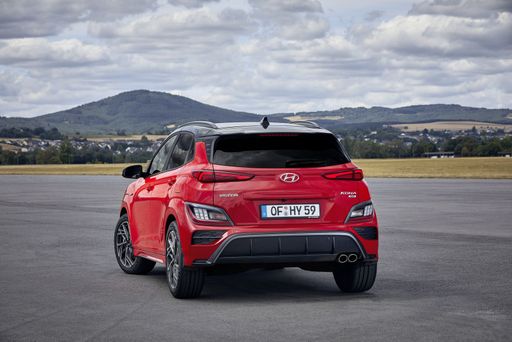 @ hyundai.news
@ hyundai.news
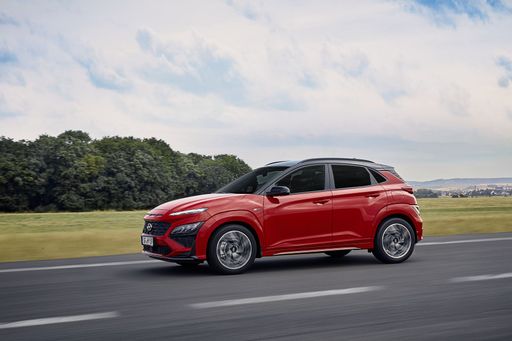 @ hyundai.news
@ hyundai.news
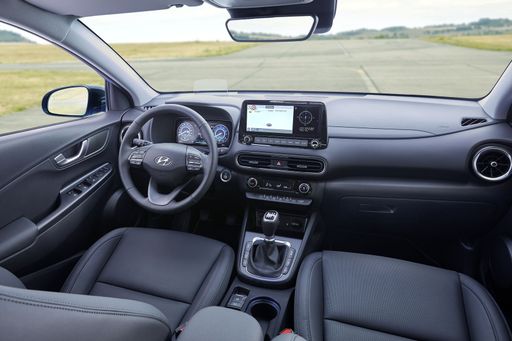 @ hyundai.news
@ hyundai.news
VW ID.5
The VW ID.5 is a stylish all-electric coupé SUV, designed to combine the practicality of an SUV with the sleek aesthetics of a coupé. Inside, the cabin offers a modern and spacious environment, featuring advanced technology that provides a seamless and intuitive driving experience. The ID.5 stands out with its dynamic performance and sustainable design, making it an attractive option for eco-conscious drivers.
details @ Volkswagen
@ Volkswagen
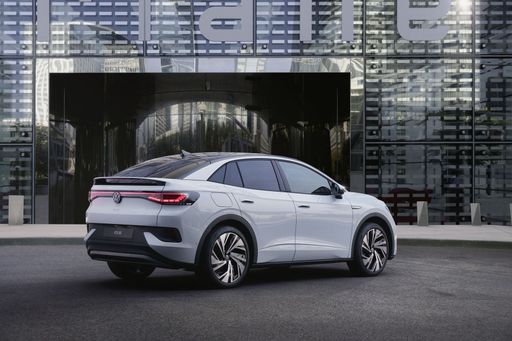 @ Volkswagen
@ Volkswagen
 @ Volkswagen
@ Volkswagen
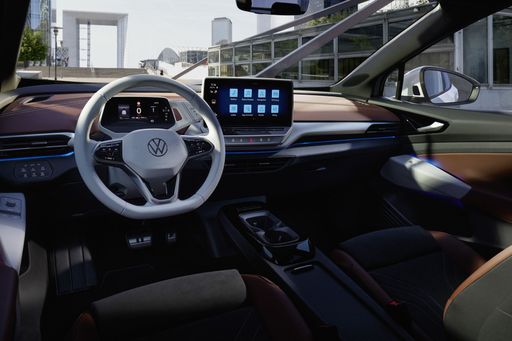 @ Volkswagen
@ Volkswagen
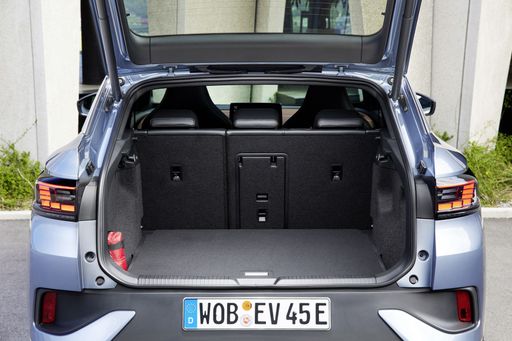 @ Volkswagen
@ Volkswagen
 @ Volkswagen
@ Volkswagen

|

|
|
|
|
Costs and Consumption |
|
|---|---|
|
Price
23100 - 41600 £
|
Price
36800 - 48400 £
|
|
Consumption L/100km
4.6 - 7 L
|
Consumption L/100km
-
|
|
Consumption kWh/100km
14.6 - 16.8 kWh
|
Consumption kWh/100km
15.7 - 16.6 kWh
|
|
Electric Range
377 - 514 km
|
Electric Range
363 - 559 km
|
|
Battery Capacity
1.3 - 65.4 kWh
|
Battery Capacity
52 - 79 kWh
|
|
co2
0 - 163 g/km
|
co2
0 g/km
|
|
Fuel tank capacity
38 - 47 L
|
Fuel tank capacity
-
|
Dimensions and Body |
|
|---|---|
|
Body Type
SUV
|
Body Type
SUV
|
|
Seats
5
|
Seats
5
|
|
Doors
5
|
Doors
5
|
|
Curb weight
1370 - 1773 kg
|
Curb weight
1963 - 2233 kg
|
|
Trunk capacity
466 L
|
Trunk capacity
549 L
|
|
Length
4350 - 4385 mm
|
Length
4582 - 4599 mm
|
|
Width
1825 mm
|
Width
1852 mm
|
|
Height
1580 - 1585 mm
|
Height
1601 - 1618 mm
|
|
Max trunk capacity
1300 L
|
Max trunk capacity
1561 L
|
|
Payload
420 - 490 kg
|
Payload
517 - 549 kg
|
Engine and Performance |
|
|---|---|
|
Engine Type
Electric, Petrol, Full Hybrid
|
Engine Type
Electric
|
|
Transmission
Automatic, Manuel
|
Transmission
Automatic
|
|
Transmission Detail
Manual Gearbox, Dual-Clutch Automatic
|
Transmission Detail
Reduction Gearbox
|
|
Drive Type
Front-Wheel Drive, All-Wheel Drive
|
Drive Type
Rear-Wheel Drive, All-Wheel Drive
|
|
Power HP
115 - 218 HP
|
Power HP
170 - 340 HP
|
|
Acceleration 0-100km/h
7.8 - 11.9 s
|
Acceleration 0-100km/h
5.4 - 8.9 s
|
|
Max Speed
162 - 210 km/h
|
Max Speed
160 - 180 km/h
|
|
Torque
200 - 265 Nm
|
Torque
310 - 679 Nm
|
|
Number of Cylinders
3 - 4
|
Number of Cylinders
-
|
|
Power kW
85 - 160 kW
|
Power kW
125 - 250 kW
|
|
Engine capacity
998 - 1598 cm3
|
Engine capacity
-
|
General |
|
|---|---|
|
Model Year
2024 - 2025
|
Model Year
2024 - 2025
|
|
CO2 Efficiency Class
A, D, C, E, F
|
CO2 Efficiency Class
A
|
|
Brand
Hyundai
|
Brand
VW
|
Is the Hyundai Kona offered with different drivetrains?
Available configurations include Front-Wheel Drive or All-Wheel Drive.
The prices and data displayed are estimates based on German list prices and may vary by country. This information is not legally binding.
